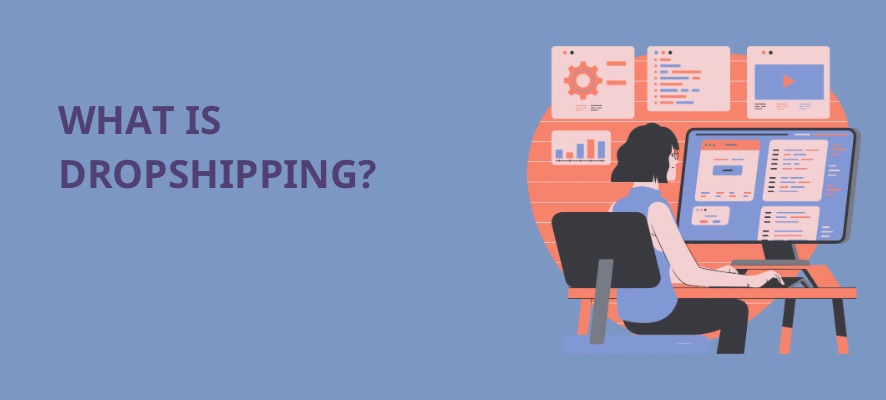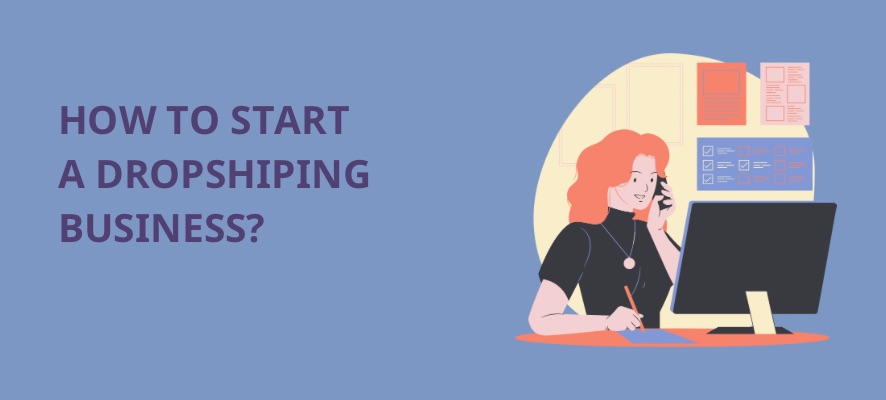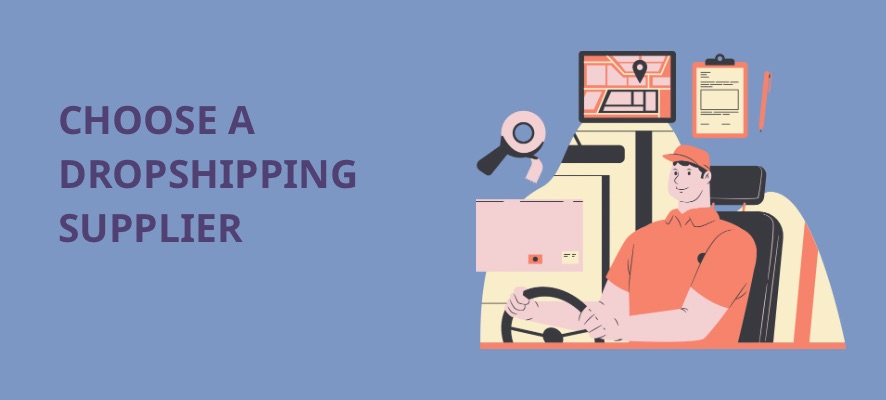Although dropshipping is not a new business plan, it will likely continue to be one of the industries with the fastest growth. This blog post will assist you in learning more about dropshipping and how to launch a dropshipping business if you wish to do so.
What Is Dropshipping?

Explained in an easy way, dropshipping is when you sell products to customers but use a third party to hold your inventory and ship your orders. A dropshipping business owner needs to be focused on branding, marketing, customer management, and many other things while a third party handles your logistics problems for you.
Dropshipping may result in a financial profit. First of all, the growth of online shopping is still strong. Additionally, because merchants don’t have to make inventory investments upfront, this keeps more capital available for other purposes.
Which type of product should you choose?

The best products for starting a dropshipping business should have high demand and low market competition. However, you can try it out if you have a creative product idea and find a potential market!
Here are some suggestions for you:
- Apparel and footwear
- Beauty and personal care
- Kitchen and dining
- Baby
- Pet supplies
- Home interiors
- Office products
- Tools and home improvement
- Phone Accessories
- Car Accessories
How To Start A Dropshipping Business

Choose a dropshipping business idea
Before you decide on your business idea, let’s take a tour through the market to find the most suitable for you!
- Marketplace Best Sellers: The biggest online markets are a great source of data to find trending products and dropshipping ideas all over the world. Let’s start with the top product pages on some famous retailer markets, for example, Amazon, Etsy, or Walmart. Pay close attention to top products that have product badges like “Best Seller”, “Amazon’s Choice”, etc. Then you can visit other wholesale marketplaces like AliExpress, Alibaba, SaleHoo, SheIn, etc.
- Pinterest Trends: Pinterest allows users to save pins that they love. If you use Pinterest Trends, you can see what users have saved the most during the previous week/month and dropship similar products through your own online store.
- Tiktok: In case your target consumers are Gen Z, you don’t miss this social media platform, which is a major shopping channel for Gen Z consumers. You can find ideas by scanning the #TikTokMadeMeBuyIt hashtag and checking the video that gets more views or is on the trend.
- Trendhunter: This is a page view of data, artificial intelligence, and research teams to discover trending products.
Do competitive research
There are many ways and factors that you can use to do a competitive research analysis. However, if you are new to research skills, you can follow these steps as a suggestion.
Step 1 – Determine who your competitors are
Divide your “competitors” into two groups: direct and indirect.
Direct competitors are businesses that offer a product or service that could pass as a similar substitute for yours, and that operate in your same geographic area.
On the other hand, an indirect competitor provides products that are different but could satisfy the same customer need or solve the same problem.
It seems simple enough on paper, but these two terms are often misused. However, you should only focus on your direct competitors.
Step 2 – Determine what products your competitors offer
Here are some questions to consider:
- Are they low-cost or high-cost providers? (Based on their price, you can determine this.)
- Are they working mainly on volume sales or one-off purchases?
- What is their market share?
- What are the characteristics and needs of their ideal customers?
- Are they using different pricing strategies for online purchases versus brick purchases?
- How does the company differentiate itself from its competitors?
- How do they distribute their products/ services?
Step 3 – Research your competitors’ sales tactics and results
Running a sales analysis of your competitors can be quite difficult; however, some questions below may help you:
- What does the sale process look like?
- What channels are they selling through?
- Do they have multiple locations, and how does this give them an advantage?
- Are they expanding? Scaling down?
- Do they have partner reselling programmes?
- What are their customers’ reasons for not buying?
- What are their revenues each year? What about total sales volume?
- Do they regularly discount their products or services?
- How involved is a salesperson in the process?
These questions may give you some ideas of how competitive the sales process is, and what information you need to prepare.
Step 4 – Take a look at your competitors’ pricing, as well as any perks they offer
One of the most important elements affecting customers purchase decisions is price. You need to understand how much your competitors are charging for a similar product or service.
The cheapest price is not only the best. You need to consider the costs you have to pay for dropshipping suppliers, platforms, etc. That’s why you need to make a correct price for your product that feels reasonable to prospects.
Step 5 – Ensure you’re meeting competitive shipping costs
The main reason for cart abandonment is expensive shipping. Nowadays, free shipping is a major element that can attract consumers to choose your brand over another.
You need to take a look at your competitors’ costs and ensure you’re meeting those prices. In case free shipping isn’t a good option for your business, you can try other ways, for example, loyalty programmes, holiday discounts, or giveaways on social media.
Step 6 – Analyse how your competitors market their products
Marketing is a way to introduce brands to more audiences. Analysing competitors’ marketing tactics is a good way to catch market trends.
- Do they have a blog?
- Are they creating whitepapers or ebooks?
- Do they post videos or webinars?
- Do they have a podcast?
- Do they use static visual content such as infographics and cartoons?
- What about slide decks?
- Do they have a FAQs section?
- Are there featured articles?
- Do you see press releases?
- Do they have a media kit?
- What about case studies?
- Do they publish buying guides and data sheets?
- What online and offline advertising campaigns are they running?
Step 7 – Take note of your competition’s content strategy
Take consideration of the following questions when analysing the content of your competitors:
- How accurate is their content?
- Are spelling or grammar errors present?
- How in-depth does their content go?
- What tone do they use?
- Is the content structured for readability?
- Is their content free and available to anyone, or do their readers need to opt in?
- Who is writing their content?
- Is there a visible byline or bio attached to their articles?
When you scan the content, you should pay attention to the photos and imagery your competitors are using. If they use stock photos, do they have overlays of text quotes or call-to-action (CTA) that are specific to their business? If their photos are custom, are they used by outside graphic professionals, or do they appear to be done in-house?
Step 8 – Learn what technology stack your competitors use
Understanding the tools that competitors use may be necessary for helping your own business reduce friction and boost momentum within the workplace.
For instance, you might have read favourable reviews about the customer service of a rival; yet, as you do your study, you discover that the client is using advanced customer service tools that you haven’t been using. With this knowledge, you should be better prepared to outperform the methods used by your competitors.
Enter the company’s URL into Built With, a useful tool for showing what technology your competitors’ site uses, along with third-party plugins ranging from analytics systems to CRMs, to find out the software your competitors are using.
As another option, you might think about browsing the job postings of your competition, especially for engineer or web developer positions. The job description will probably specify the tools a candidate must be knowledgeable with, which is a clever way to learn about the technology that your competitors employ.
Step 9 – Analyze the level of engagement on your competitors’ content
Check the average number of comments, shares, and likes on your competitor’s content, pay attention to these:
- Certain topics resonate better than others
- The comments are negative, positive, or a mix
- People are tweeting about specific topics more than others
- Readers respond better to Facebook updates about certain content
- Don’t forget to note if your competitor categorizes their content using tags, and if they have social media follow and share buttons attached to each piece of content.
Step 10 – Observe how they promote marketing content
To find out which content promotion strategy your competitors have used, you need to check keyword density in the copy itself, image alt text tags, and the use of internal linking.
The following questions can help you:
- Which keywords are your competitors focusing on that you still haven’t tapped into?
- What content of theirs is highly shared and linked to? How does your content compare?
- Which social media platforms are your target audience using?
- What other sites are linking back to your competitor’s site, but not yours?
- Who else is sharing what your competitors are publishing?
- Who is referring traffic to your competitor’s site?
- What is the difficulty level of keywords that you want to focus on?
Step 11 – Look at their social media presence, strategies, and go-to-platforms
Check the social media platforms that your competitors have used and take note of these data points:
- Number of fans/followers
- Posting frequency and consistency
- Content engagement (comments and shares of their audiences)
- Content virality (number of shares, repins, and retweets of their posts)
Step 12 – Perform a SWOT Analysis to learn their strengths, weaknesses, opportunities, and threats
SWOT is a kind of analysis report in which you can find and note your competitor’s strengths, weaknesses, opportunities, and threats. For a SWOT analysis, you need to start with these questions:
- What is your competitor doing well?
- Where does your competitor have an advantage over your brand?
- What is the weakness of your competitor?
- Where does your brand have an advantage over your competitor?
- What could they do better?
- In what areas would you consider this competitor a threat?
- Are there opportunities in the market that your competitor has identified?
Choose a dropshipping supplier

Nowadays, there are a lot of dropshipping suppliers working in every country in the world. After determining which target market you want to sell to, let’s start with two steps:
Step 1 – Find a dropshipping supplier
Just a quick search on the internet to find one. On the other hand, if you are concerned about the quality and worry about the scam, you can contact a third-party organisation, also known as the fulfillment business, which already filters the suppliers. Additionally, if your area has local suppliers, you can contact them directly and visit their factories.
Step 2 – Choose a dropshipping supplier.
To ensure that your business grows better and better, these are things you need to consider before finally deciding on one: high product quality, agreement pre-order fee, good shipping speed, experienced staff and sales representatives, and return policies.
Build your ecommerce store
There are a lot of platforms that can help you build an ecommerce store like Shopify, Woocommerce, WordPress, etc. If you are a non-code-skilled seller, we recommend you use Shopify. For more information on how to build an eCommerce online store with Shopify, check out the blog How To Start A Successful Shopify Store.
Decide on a business structure
With an eCommerce business, there are multiple business structures that you can choose from when starting your ecommerce business.
- Sole Proprietorship
- Partnerships
- Corporation
- Limited Liability Company (LLC)
Get your finances in order
Finances are another important factor that you need to consider when starting and maintaining your ecommerce business. Here are things you need to remember about managing your finances:
- Understand the incoming and outgoing
- Use the right software/platform for your business
- Plan your budget and further spending
- Regularly track and maintain your finances to be ready for tax season
- Evaluate and examine ways to improve your finances
- Invest in payroll as you grow
- Set aside time for the day-to-day management
- Put finances first in business planning
- Work with a professional accountant to handle your finances (if needed)
Market your dropshipping store
These are some ways that you can use to drive more traffic to your dropshipping store:
- Build a high-traffic converting dropshipping website
- Put your SEO content
- Using email marketing
- Choose your social media strategy
- Join an online community
- Start a YouTube channel
- Spend on advertising
Analyze and improve your offering
Testing and improving the products or services that you offer is a must-have step to making your dropshipping business better and better every day.
Listening to your customers’ opinions is a good way to know if your products or services have advantages and disadvantages. Then fix and improve them to be more high-quality!
In Conclusion
Starting a dropshipping business is never easy; however, it’s never too late to start your own. Let’s find a creative idea and start it today!



